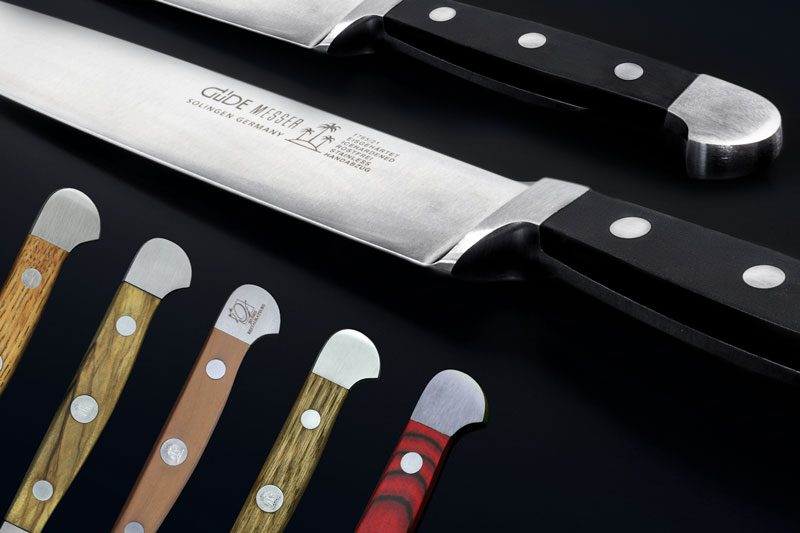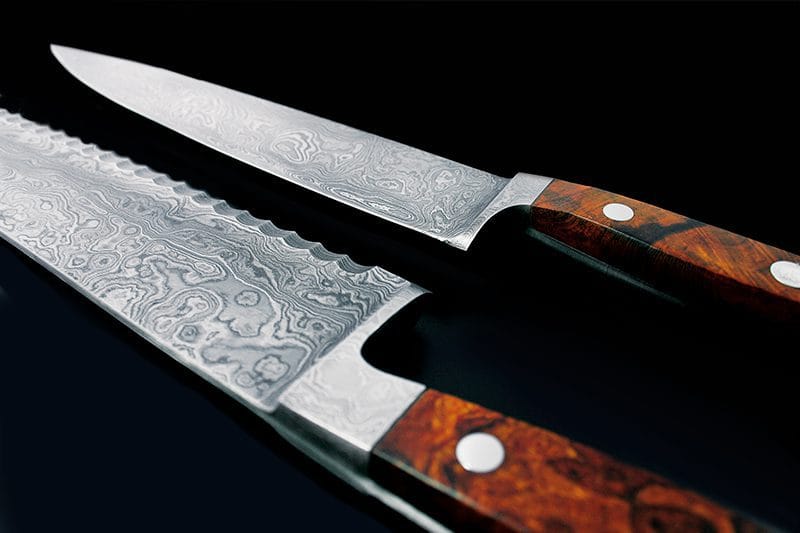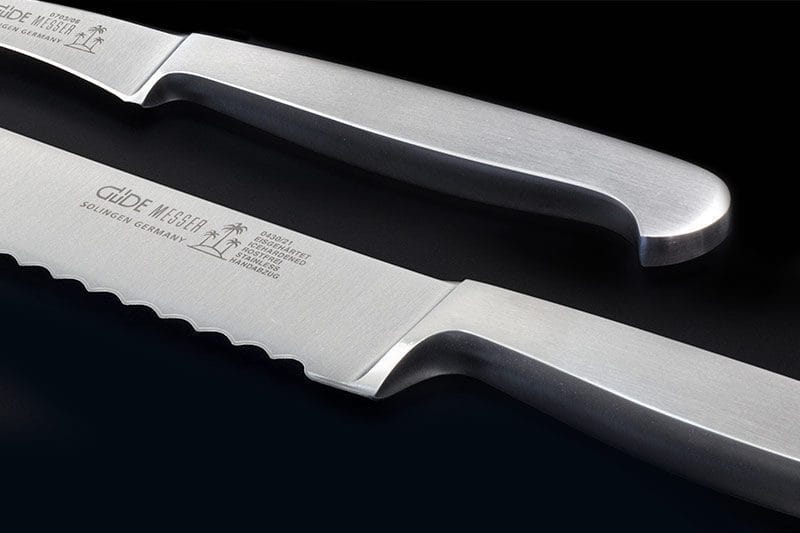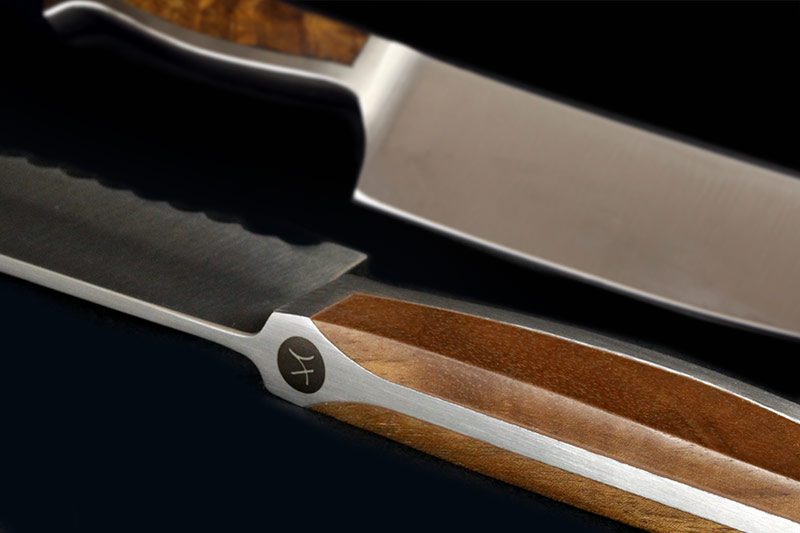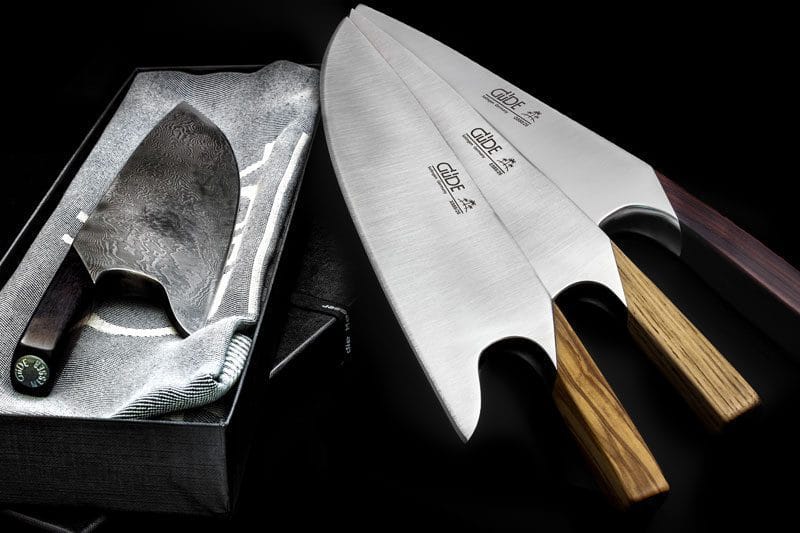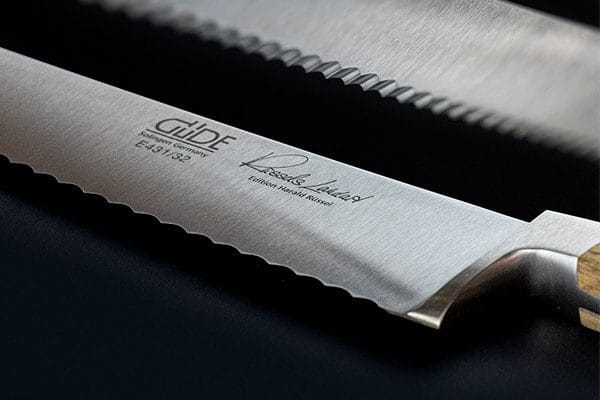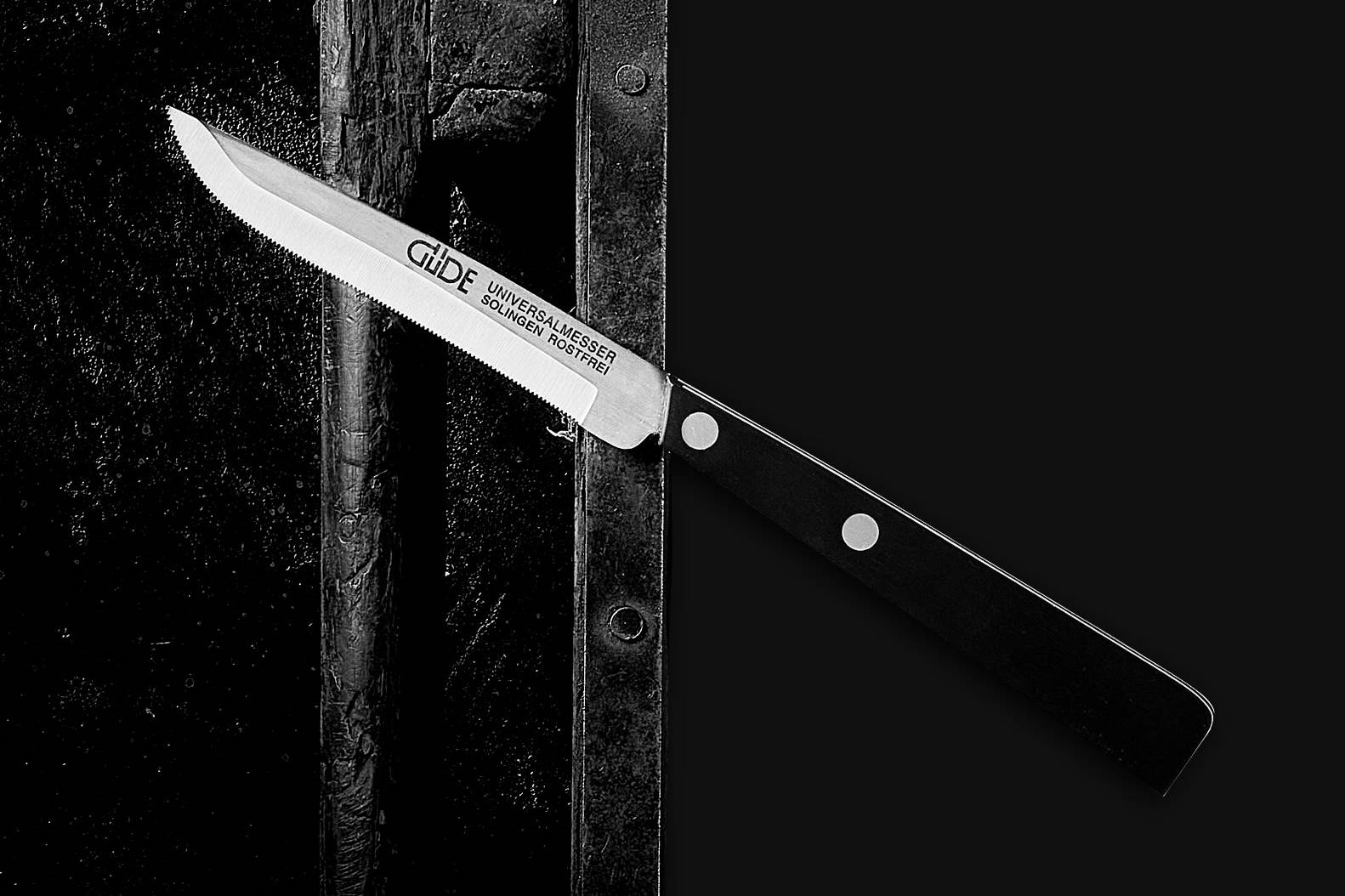SYNCHROS
The SYNCHROS series has won many awards and test prizes. The design of these knives deliberately dispenses with the so-called "bolster", the thickening between the blade and the handle, which for a long time was considered a typical feature of forged knives. The seamless transition from the handle to the blade of the SYNCHROS knives creates a completely new haptic and functional experience - an innovation of the knife manufacturer GÜDE.

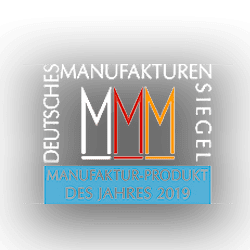
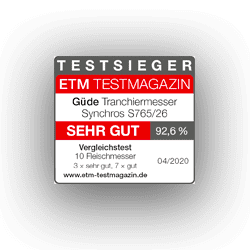
A completely new cutting experience.
- innovative handle design
- novel raised grip position
- always the same handle size
- Continuous underlying Erl
- solid convex wooden handle made of smoked oak
- smooth transition between handle and blade
- forged from one piece
- Ground through blade at the beard
- Slightly convex shape of the bevel
Thanks to the unique design, the position of the hand and fingers can be freely chosen according to taste. Hand and knife are always in sync, hence the name of the series. The raised handle position also creates a safe distance from the cutting board. The knife series SYNCHROS from GÜDE is "harmonious in design and function", according to the Association of German Manufactures (Verband DEUTSCHE MANUFAKTUREN e.V.), which voted the knife series the Manufacture Product of the Year 2019.
Such a design language can only be realised in the traditional drop-forging process. The blade is ground through to the end, the transition from blade to handle is smooth, forged from one piece of steel using a centuries-old technology. More than 40 further manual operations are necessary to produce a unique piece of innovative Solingen knifemaking art. The blade is stainless, ice-hardened and of course hand-sharpened. Due to the smoked oak handles, these knives should not be put in the dishwasher.
With only four blade designs for (almost) all applications.
BREAD KNIFE
298,00 €Select version This product has several variants. The options can be selected on the product page
The blade material of knives must sometimes fulfil contradictory requirements. It is therefore crucial to weigh up the different requirements and ensure an optimum. On the one hand, the knife steel should be hard, but not too hard, otherwise there is a risk that the blade will break under heavy use. On the other hand, however, the knife steel should not be too soft either, as ongoing wear and tear would cause the knife to lose its sharpness too quickly during use. That is why the knives in the SYNCHROS series from GÜDE are made of a chrome-molybdenum-vanadium knife steel. This steel perfectly meets the sometimes contradictory requirements thanks to an optimal hardness of approx. 57-58 HRc (Rockwell).The hardness of the knife steel of the SYNCHROS series of 57-58 HRc is not too hard and not too soft for the different requirements that a good knife must meet.Such a degree of hardness makes the blade of knives from the SYNCHROS series torsionally stiff, thus guaranteeing exact guidance of the knife and thus a precise cut. But even a hard steel, such as the GÜDE knife steel, can be ground very thin. So even a hard steel can be very flexible. The carving knife from the SYNCHROS series is rigid at the back and thinly ground at the front, making it flexible. This makes the blade suitable not only for perfect carving of meat and sausage, but also for filleting fish thanks to its flexibility. To do this, move the blade backwards and forwards between the skin and the fillet while applying light pressure....read more
All knives in the SYNCHROS series are traditionally drop-forged - from one piece of steel. The result of this traditional technology of drop forging is a particularly high material strength, even when the knife is subjected to dynamic stresses. During the forging process, the entire forging blank is heated in the die until it glows red and is then deformed between the two dies, the upper and lower die. In further very detail-oriented manual work steps, the drop-forged blank is turned into an innovative one-of-a-kind knife from the knife manufactory GÜDE - handmade.After forging in the die, the knives are punched out of the forging blank and then roughly ground, calibrated and cleaned. The contours are then milled in the area of the handle. This is followed by so-called ice-hardening: the knives are cooled to -80 °C to improve the structure of the microstructure in the blade steel. In the next step, the knives are tempered in two stages. Tempering is a term used by the knife makers in Solingen. Tempering means that the knife is heated again and thus made unbreakable. Now the blade is pre-ground. This is followed by the pre-grinding of the back of the knife, which is the upper part of the knife. This is followed by the fine grinding of the back of the knife and the grinding of the transition between the blade and the handle. The inner sides are now pre-ground for the attachment of the u-shaped handle shell. Pre-grinding of the lower tang and the circumferential end of the handle takes a further 5 steps. Only then can the blade be fine-ground. The Solingen knifemaker also calls this "pliesten". This gives the blade its unmistakable surface. The u-shaped smoked oak handle is now placed on the knife handle from above, glued and adjusted. A further five or so operations are required to roughly sand the u-shaped handle shell on the tang below and the circumferential end of the handle so that the transitions between wood and steel are smooth. These five steps must then be repeated with a finer abrasive belt. Now the upper part of the knife, the back, is given its finishing touch. This is followed by the finest grinding of the flowing transition between the blade and the handle. Then the knife handles are pre-polished, followed by fine polishing. Only now does the knife get its sharpness trigger, because the knife edge, also called the bevel, is now sharpened (the knifemaker calls this "honing"). The edge is polished so that it glides better through the food. The bread knife is given the special GÜDE serrated edge with particularly sharp teeth. In the next step, the GÜDE logo is etched onto the blade. Cleaning and quality control are the final steps. After that, the knives receive a sheath for protection. Last but not least, the shipping bags are provided with rivets and the labels belonging to the series and the blade type. The finished knives are now stored and ready for shipping....read more
The technology of forging in the die creates degrees of freedom in the design language that enable new designs and thus new functionalities. From the end of the handle to the tip of the knife, shapes can be realised that would not be feasible in any other forging technology. For example, the innovative design language with the flowing transition from handle to blade from SYNCHROS is only possible in the drop forging process. This explains impressively why GÜDE has remained true to this proven and traditional technology since its founding in 1910, now in its fourth generation.
The knives in the SYNCHROS series deliberately do without the so-called "bolster", the thickening between the blade and the handle, which for a long time was considered a typical feature of forged knives.The seamless transition from handle to blade of the SYNCHROS knives creates a completely new haptic and functional experience - an innovation of the knife manufacturer GÜDE. The position of hand and fingers can now be freely chosen according to taste. Hand and knife are always in sync, hence the name of the series. The continuous tang at the bottom and the wrap-around end of the handle give the knives in the SYNCHROS series their well-balanced appearance. The term tang refers to the part of the steel to which the u-shaped handle of the knife in the SYNCHROS series is attached and fastened from above. When the tang goes from the blade to the end of the handle, it is called a full tang.All knives in the SYNCHROS series from GÜDE have a full tang.Because the full tang is on the underside of the handle, the inside of the hand does not come into contact with the cold steel, but with the pleasant feel of the wood of the smoked oak. The full tang, in conjunction with the wrap-around end of the handle, gives the knives a perfect balance of weight. Completely visible over the entire length of the handle, the full tang is virtually proof that the knives in the SYNCHROS series are forged from a single piece. No material transition, no seam - just as it should be with a knife that has been drop-forged from one piece....read more
A good knife should not only be sharp, it should also stay sharp for as long as possible. A good knife should also lie well in the hand and be balanced so that fatigue-free and safe work is guaranteed at all times.
Sharpness and edge retention of the SYNCHROS series are ensured both by the optimum hardness of the GÜDE blade steel with approx. 57-58 HRc (Rockwell) and by the GÜDE bevel angle of approx. 33 degrees. In addition, the blade of the knives in the SYNCHROS series is ground through to the beard, which also predestines them for Asian cuisine. Chef's knives and preparation knives also meet the requirements of a Santoku knife.
The innovative shape of the handle allows the user to handle the knife according to his or her individual taste or application. In addition, the raised handle position guarantees optimum use of force and at the same time safe distance from the cutting board.Sharpness and cutting durability are determined not only by the blade material but also by the angle of the blade: cutting is like driving a wedge through a material to be cut. The more acute the angle of the wedge, i.e. the bevel angle, the easier it is to drive the wedge through the material to be cut. The term "bevel" is the knifemakers' term for the cutting edge, i.e. the sharply ground part of a knife. An acute bevel angle makes a knife sharper than a blunt bevel angle. If the bevel angle is too acute, however, the bevel can break. That is why the knives in the SYNCHROS series from GÜDE have an optimum bevel angle of approx. 33 degrees. This angle guarantees both sharpness and stability. The chrome-molybdenum-vanadium blade steel of the SYNCHROS series guarantees long-lasting sharpness with its hardness of approx. 57-58 HRc (Rockwell). It is important to always cut on a suitable cutting surface, e.g. wood or plastic. The almost proverbial balance of the knives in the SYNCHROS series is a result of the full tang located on the underside of the handle and the wrap-around end of the handle. This creates a counterweight to the blade in the area of the handle. For the user this means: Perfect balance and fatigue-free work with a secure grip at all times. SYNCHROS synchronises hand and knife. Regardless of whether the user wants to use the knife in the familiar "standard" grip posture or in a "hybrid" posture or in "overgrip", SYNCHROS ensures that hand and knife are always aligned. And to ensure that these advantages can be used in the same way on all knives, all knives in the SYNCHROS series have the same handle size. The size of the handle is based on the human hand and perfect function, but not on blade length. The knives of the SYNCHROS series are the striking proof that with a traditional technology such as drop forging, groundbreaking innovations are nevertheless possible for the benefit of the user....read more
GÜDE SYNCHROS with Brian Bojsen
GÜDE SYNCHROS Chef's knife
GÜDE SYNCHROS Bread knife
GÜDE SYNCHROS Preparation knife
GÜDE SYNCHROS Carving knife
GÜDE SYNCHROS
Our knife series
We value individuality - especially in the development and optimisation of our knife series. This is reflected in every single blade that leaves our manufactory, in the selection of particularly beautiful and tactile handle materials and a unique ergonomic design that fluently enables and celebrates fast, precise work.
Discover knife icons
THE KNIFE.
Our THE KNIFE. lives up to its name: this all-rounder was conceived, developed and forged by us with a particular focus on perfect ergonomics. Its special shape and balance ensure an automatic over-grip of the hand, which encloses the blade when cutting and thus finds a quasi natural extension in THE KNIFE.
Güde Bread knife
Developed in 1941 by the heir to the manufactory Franz Güde , the special "GÜDE serrated edge" of our bread knives today delights bakers and bread lovers all over the world. The pointed teeth of the unyielding, sharply ground chrome-vanadium-molybdenum steel ensure that breads, baguettes and rolls can be sliced instead of squashed, but also cabbages, melons and crispy crusted roasts can be cut more easily than ever. Unadorned, beautiful handles made of different high-quality materials do the rest for this knife legend of ours.
Utility knife
Our compact all-round talent is handy and effective - not only when it comes to precise work with smaller items. Its fine serration and double-sided hollow grinding make our universal knife the ideal companion for peeling, cutting and slicing vegetables, meat, fruit and co.









